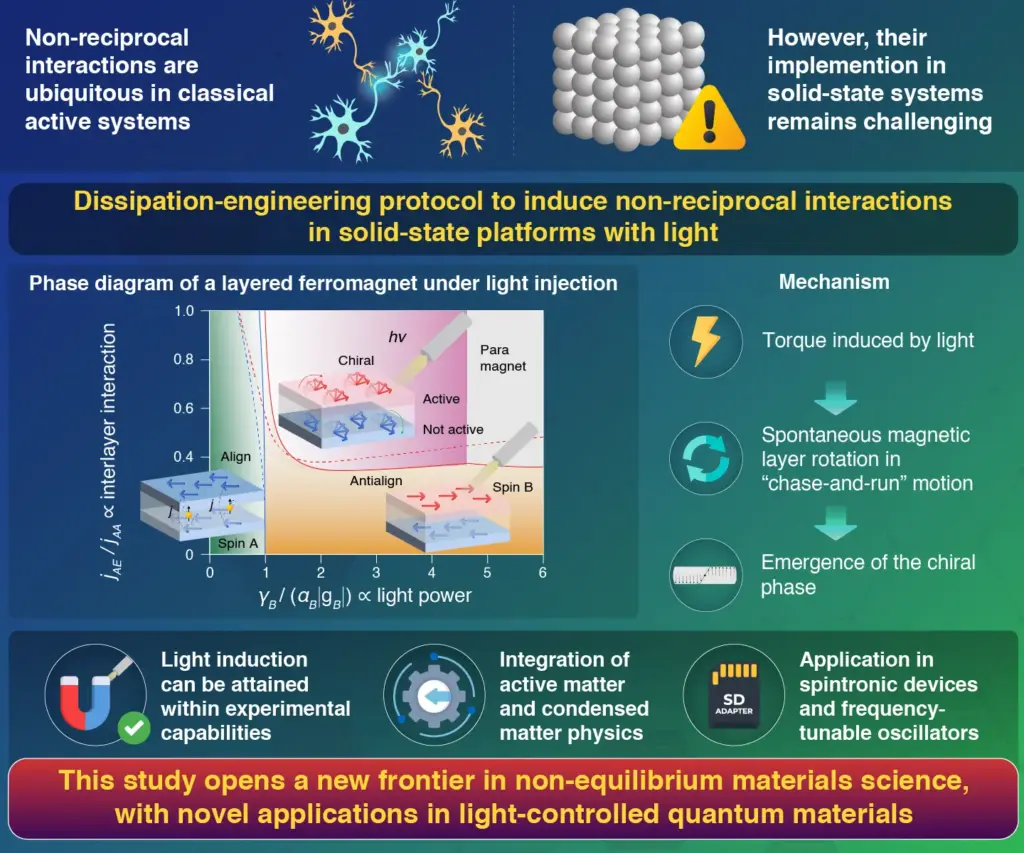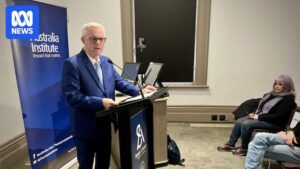
A groundbreaking theoretical framework predicts the emergence of non-reciprocal interactions in solids using light, effectively challenging Newton’s third law, according to researchers from Japan. The team demonstrates that by irradiating light of a carefully tuned frequency onto a magnetic metal, it is possible to induce a torque that drives two magnetic layers into a spontaneous and persistent “chase-and-run” rotation. This discovery opens new avenues in non-equilibrium materials science and suggests innovative applications in light-controlled quantum materials.
In traditional equilibrium systems, physical laws such as the principle of action and reaction hold firm. However, in non-equilibrium systems, such as biological or active matter, non-reciprocal interactions are prevalent. Examples include the asymmetric interactions between predator and prey or the non-reciprocal interactions in colloids immersed in optically active media. This raises the intriguing question: Can such interactions be implemented in solid-state electronic systems?
Artificial Induction of Non-Reciprocal Interactions
A research team led by Associate Professor Ryo Hanai from the Department of Physics at the Institute of Science Tokyo, in collaboration with Associate Professor Daiki Ootsuki from Okayama University and Assistant Professor Rina Tazai from Kyoto University, has answered this question affirmatively. They propose a theoretical method to induce non-reciprocal interactions in solid-state systems using light. Their findings were published in the journal Nature Communications on September 18, 2025.
“Our study proposes a general way to turn ordinary reciprocal spin interactions into non-reciprocal ones using light,” explains Hanai. “For instance, we show that a well-known interaction in magnetic metals—the Ruderman–Kittel–Kasuya–Yosida (RKKY) interaction—can acquire a non-reciprocal character when the material is irradiated with light at a frequency that selectively opens a decay channel for certain spins, while leaving others off-resonant.”
Dissipation-Engineering Scheme
Inspired by the ubiquity of active and non-reciprocal phenomena in nature, the team developed a dissipation-engineering scheme using light to selectively activate decay channels in magnetic metals. These metals possess localized spins and freely moving conduction electrons, leading to spin-exchange coupling. By activating decay channels, the researchers create an imbalance in energy injection between different spins, resulting in non-reciprocal magnetic interactions.
Applying this scheme to a bilayer ferromagnetic system, the researchers predicted a non-equilibrium phase transition termed a non-reciprocal phase transition. This was previously introduced by one of the authors in the context of active matter, where one magnetic layer attempts to align with another, while the other tends to anti-align when irradiated with light. This leads to a spontaneous and continuous rotation of magnetization—a “chiral” phase characterized by persistent chase-and-run dynamics.
Implications and Future Applications
The implications of this research are far-reaching. The required light intensity for inducing non-reciprocal phase transitions is estimated to be within reach of current experimental capabilities. “Our work not only provides a new tool for controlling quantum materials with light but also bridges concepts from active matter and condensed matter physics,” concludes Hanai. “It could be applied to Mott insulating phases of strongly correlated electrons, multi-band superconductivity, and optical phonon-mediated superconductivity.”
This work could potentially enable the development of new types of spintronic devices and frequency-tunable oscillators. By shedding light on the applicability of non-reciprocal interactions to solid-state systems, the research holds promise for innovative next-generation technologies.
Conclusion
Overall, this breakthrough in light-induced non-reciprocal effects in magnetic metals represents a significant leap in materials science. By bridging the gap between active matter and condensed matter physics, the research not only challenges existing scientific paradigms but also paves the way for novel technological advancements in quantum materials and beyond.






